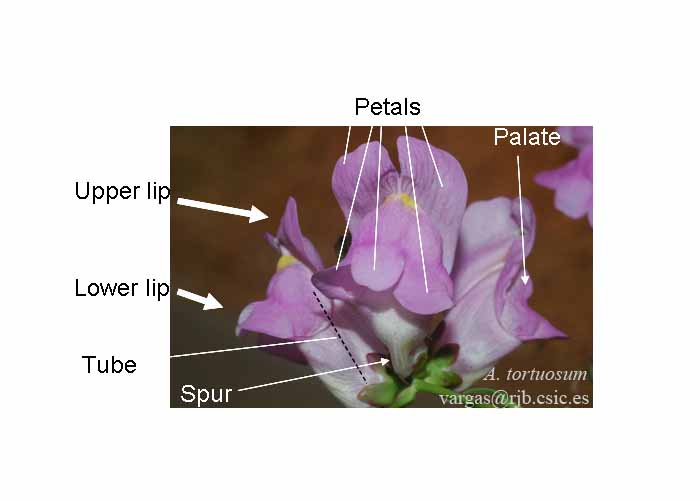Antirrhinum has a complex taxonomy because of recent spectiation processes and limited genetic barriers for hybridization. All species display the same personate flower in terms of shape, while size and color depend primarily on species circumscription.

Antirrhinum L., Sp. Pl. ed. 1 2: 612 (1753). Dwarf shrubs or suffrutescent perennial herbs; stems homomorphic, usually erect or ascending, the lateral branches sometimes twining. Leaves homomorphic, simple, entire, orbicular to linear, entire, pinnately veined, sessile or petiolate, opposite below to alternate above. Flowers zygomorphic, pedicellate, in terminal bracteate racemes or solitary in leaf-axils. Floral leaves or bracts not subtending additional branches. Pedicels not cirrhous. Calyx deeply divided, the lobes entire, more or less equal, imbricate, shorter than corolla-tube. Corolla with tube broad, more or less cylindrical, inconspicuously gibbous or shortly saccate abaxially at base; limb bilabiate, the lips equal or subequal, the adaxial lip usually exceeding abaxial, erecto-patent to patent, the abaxial lip erect to patent with a prominent basal palate occluding or rarely partially occluding mouth of tube; lobes entire. Fertile stamens 4, didynamous, included, the adjacent pairs of anthers marginally coherent, the connective not dilated above anther; staminode minute. Style erect, simple; stigma capitates, entire, positioned between anthers of fertile stamens. Capsule ovoid to suboribicular, the walls coriaceous, the septum erect, straight or sinuate; loculi unequal or subequal, many-seeded, the adaxial loculus exceeding abaxial, narrower above and dehiscing by solitary, irregularly-toothed pore, the abaxial loculus broader above, dehiscing simultaneously with or somewhat later than adaxial loculus, opening by 2 irregularly toothed pores. Seeds ovoid to oblong-ovoid, more or less radially symmetrical, reticulate, reticulate-alveolate or cristate, the hilum more or less basal, the ridges somewhar thin, regularly or irregularly anastomosed; periclinal wall of testa-cells from interstices tabular-convex with median papilla, that of cells from ridges usually tabular, sometimes with marginal papilla; epicuticular waxes usually present, granulate. Modified from Sutton (1988)

